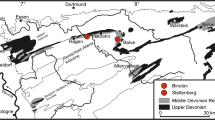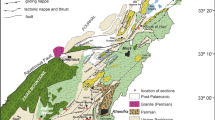Abstract
Reefs in the Late Ordovician are usually built up by metazoans, whereas in the Early and Middle Ordovician microbial reefs are dominating. In the Late Ordovician (Katian) Lianglitag Formation, at Bachu, Tarim, NW China, however, three distinct stages of thrombolithic microbial reefs are exposed. The lower and upper reef intervals are characterized by widespread microbial carbonates with almost constant thicknesses (biostromes). The middle reef interval exposes dome-like mounds, and shows a higher diversity of reef-building and reef-dwelling organisms. Calcareous algae such as Vermiporella are abundant, but also other components such as fragments of Halysis, brachiopods, molluscs, echinoderms, bryozoans, and trilobites have been found in the microbial reef units. The purpose of this study is to describe for the first time the composition and microfacies of the reefs in this remote area. Especially the question of whether or not these Late Ordovician reefs represent remnants of the Early/Middle Ordovician microbial-dominated reef type just lacking Calathium and lithistid sponge is addressed. The results indicate that the local conditions on the leeward side of the carbonate platform, where waters are less well agitated and thus less well oxygenated, and probably also characterized by temporarily elevated water temperatures hampering the growth of metazoan reefs, were responsible for the proliferation of the Late Ordovician microbial reefs in the Bachu area.









Similar content being viewed by others
References
Calner M (2005a) A Late Silurian extinction event and anachronistic period. Geology 33:305–308
Calner M (2005b) Silurian carbonate platforms and extinction events: ecosystem changes exemplified from Gotland, Sweden. Facies 51:584–591
Chen X, Qiu JY (1986) Ordovician palaeoenvironmental reconstruction of Yichang area. J Stratigr 10(1):1–15
Chen JY, Lindstrom M, Zhang JM (1991) Pagoda facies: a “fashion” biosedimentation of Ordovician time. Palaeoworld 1:28–29
Copper P (1976) The cyanophyte Wetheredella in Ordovician reefs and off-reef sediments. Lethaia 9:273–281
Copper P, Brunton F (1991) A global review of Silurian reefs. In: Bassett MG, Lane PD, Edward D (eds) The murchison symposium: proceedings of an international conference on the Silurian system. Palaeontology Spec Pap, vol 44, pp 225–260
Eberli GP (1991) Growth and demise of isolated carbonate platforms: Bahamian controversies. In: Müller D, McKenzie JA, Weissert H (eds) Controversies in modern geology. Academic Press, London, pp 231–248
Feng Q, Gong YM, Riding R (2010) Mid-Late Devonian calcified marine algae and cyanobacteria, south China. J Paleont 84:569–587
Flügel E (2004) Microfacies of carbonate rocks, analysis, interpretation and application. Springer, Berlin Heidelberg New York
Frisch K, Munnecke A, Schulbert C, Zhang YD (2013) Tubes or cell sheet? A 3-D reconstruction of Halysis Høeg, 1932, from the Upper Ordovician of South China. Facies 59:113–132
Gao ZQ, Fan TL, Li Y, Liu WH, Chen YL (2006) Study on eustatic sea-level change rule in Cambrian-Ordovician in Tarim Basin. J Jilin Univ (Earth Sci Edit) 36:549–556
Gnilovskaya MV (1965) Ordovician algae of the genus Vermiporella from Tarbagatay range. Intern Geol Rev 7:2105–2114
Gu JY (1996) Characteristics of sedimentary sequences in Tarim Basin. Petroleum Industry Press, Beijing
Gu JY (2001) Finding and significance of Ordovician reefs in Tarim Basin. Petrol Explor Dev 28:1–3
Gu JY, Zhang XY, Luo P, Luo Z, Fang H (2005) Development characteristics of organic reef-bank complex on Ordovician carbonate platform margin in Tarim Basin. Oil Gas Geol 26:277–282
Haq BU, Schutter SR (2008) A chronology of Paleozoic sea-level changes. Science 322:64–68
Huang BC, Zhu RX, Otofuji Y, Yang ZY (2000) The early Paleozoic paleogeography of the north China block and the other major blocks of China. Chin Sci Bull 45:1057–1058
Jarochowska E, Munnecke A, Kozłowski W (2014) An unusual microbial-rostroconch assemblage from the Mulde Event (Homerian, middle Silurian) in Podolia, western Ukraine. Geol Foren Forhandl (in press)
Jia CZ, Wei GQ, Yao HJ (1995) Tectonic evolution and regional structure geology of the Tarim Basin. Petroleum Industry Press, Beijing
Jia CZ, Zhang SB, Wu SZ (2004) Stratigraphy of the Tarim Basin and adjacent areas. Science Press, Beijing, pp 44–110
Kershaw S, Crasquin S, Collin P-Y, Li Y, Feng QL, Forel MB (2009) Microbialites as disaster forms in anachronistic facies following the end-Permian mass extinction: a discussion. Aust J Earth Sci 56:809–814
Kuznetsov VG (1990) The evolution of reef structure through time: importance of tectonic and biological control. Facies 22:159–168
Li Y, Kershaw S, Mu XN (2004) Ordovician reef systems and settings in South China before the Late Ordovician mass extinction. Palaeogeogr Palaeoclimatol Palaeoecol 205:235–254
Li Y, Huang ZB, Wang JP, Wang ZH, Xue YS, Zhang JM, Zhang YD, Fan JX, Zhang YY (2009) Conodont biostratigraphy and sedimentology of the Mid-Upper Ordovician, Buchu, Xinjiang, NW China. J Stratigr 33:113–122
Munnecke A, Servais T, Vachard D (2001) Halysis Høeg, 1932—a problematic Cyanophyceae: new evidence from the Silurian of Gotland (Sweden). N Jb Geol Paläont Mh 2001:21–42
Ni YN, Geng LY, Wang ZH, Zhao ZX, Chen TE, Zhang YB, Wang HF, Zhang SG, Yuan WW, Zhang SB, Gao QQ, Li J (2001) Ordovician. In: Zhou ZY (ed) Stratigraphy of the Tarim Basin. Beijing Science Press, Beijing, pp 39–80
Nikitin IF, Popov LE (1996) Strophomerid and triplesiid brachiopods from an Upper Ordovician carbonate mound in central Kazakhstan. Alcheringa 20:1–20
Nikitin IF, Gnilovskaya MB, Zhuravleva IT, Luchinina VA, Myaagkova EI (1974) Anderkenskaya biogermnaya i historia ego obrazhovaniya (Anderken bioherm range and the history of its origin). In: Betekhtina OA, Zhuravleva IT (eds) Sreda i zhizn’ v geologicheskom proshlom–paleoekologicheskie problemii (Environment and life in the geological past–paleoecological problems), pp 122–159
Nikitin IF, Popov LE, Holmer LE (1996) LateOrdovician brachiopod assemblage of Hiberno–Salairian type from Central Kazakhstan. Geologiska Foreningens i Stockholm Forhandlingar 118:83–96
Pratt BR (1984) Epiphyton and Renalcis: diagenetic microfossils from calcification of coccoid blue-green algae. J Sediment Petrol 54:948–971
Pratt BR (2001) Calcification of cyanobacterial filaments: Girvanella and the origin of lower Paleozoic lime mud. Geol Soc Am 29:763–766
Purser BH (ed) (1973) The Persian Gulf. Holocene carbonate sedimentation and diagenesis in a shallow epicontinental sea. Springer, Berlin Heidelberg New York
Riding R (1977) Systematics of Wetheredella. Lethaia 10:94
Riding R (2000) Microbial carbonates: the geological record of calcified bacterial–algal mats and biofilms. Sedimentology 47(Suppl 1):179–214
Riding R (2002) Structure and composition of organic reefs and carbonate mud mounds: concepts and categories. Earth Sci Rev 58:163–231
Riding R (2005) Phanerozoic reefal microbial carbonate abundance: comparisons with metazoan diversity, mass extinction events, and seawater saturation state. Rev Espan Micropaleont 37:23–39
Riding R (2006) Microbial carbonate abundance compared with fluctuations in metazoan diversity over geological time. Sedimentology 185:229–238
Riding R, Braga J (2005) Halysis Høeg, 1932—an Ordovician coralline red alga? J Paleont 79:835–841
Riding R, Liang LY (2003) Seawater saturation state and the Phanerozoic secular distribution of microbial carbonates. In: Abstracts, 8th international symposium on Fossil Algae, Granada, Spain, 18–20 September 2003, pp 63–64
Sepkoski JJ, Bambach RK, Droser ML (1991) Secular changes in Phanerozoic event bedding and the biological overprint. In: Einsele G, Ricken W, Seilacher A (eds) Cycles and events in stratigraphy. Springer, Berlin Heidelberg New York, pp 298–312
Shields GA, Veizer J (2004) Isotopic signatures. In: Webby BD, Droser ML, Paris F, Percival IG (eds) The Great Ordovician Biodiversification Event. Columbia University Press, New York, pp 68–71
Trotter JA, Williams IS, Barnes CR, Lécuyer C, Nicoll RS (2008) Did cooling oceans trigger Ordovician biodiversification? Evidence from conodont thermometry. Science 321:550–554
Wang ZH, Qi YP (2001) Ordovician conodonts from drillings in the Taklimakan Desert, Xinjiang, NW China. Acta Micropalaeont Sinica 18:133–148
Wang ZH, Zhou TR (1998) Ordovician conodonts from western and northeastern Tarim and their significance. Acta Palaeont Sinica 37(2):173–193
Wang ZH, Bergström SM, Lane HR (1996) Conodont provinces and biostratigraphy in the Ordovician of China. Acta Palaeont Sinica 35(3):26–58
Wang ZH, Li Y, Wang JP, Ma JY, Yao XG, Huang ZB, Zhang YY (2009) Upper Ordovician conodonts from the central high, Tarim Block, NW China. Acta Micropalaeont Sinica 26:97–116
Webby BD (2002) Patterns of Ordovician reef development. In: Kiessling W, Flügel E, Golonka J (eds) Phanerozoic reef patterns. SEPM Spec Publ, vol 72, pp 129–179
Webby BD, Droser ML, Paris F, Percival IG (eds) (2004) The Great Ordovician Biodiversification Event. Columbia University Press, New York
Wilkinson BH, Walker JCG (1989) Phanerozoic cycling of sedimentary carbonate. Am J Sci 289:525–548
Wood R (1999) Reef evolution. Oxford University Press, Oxford
Xie XA, Lu HF, Wu QZ (1996) Infrastructure and Sinian rift of Tarim Basin. J Nanjing Univ Nat Sci 32:722–727
Xiong JF, Wu T, Ye DS (2006) New advances on the study of Middle-Late Ordovician conodonts in Bachu, Xinjiang. Acta Palaeont Sinica 45:359–373
Yan L (1995) Structures and oil-gas traps. In: Book series on petroleum exploration in the Tarim. Petroleum Industry Press, Beijing
Yang HJ, Wang JP, Huang ZB, Yao XG, Zhang YY, Ma JY, Li Y (2009) Biota and palaeoecology of the Lianglitag Formation (Katian, Upper Ordovician), Central Tarim, NW China. Acta Palaeont Sinica 48:109–122 (in Chinese with English abstract)
Zhang LJ, Li Y, Zhou CG, Li M, Han J, Zhang B (2007) Lithofacies paleogeographical characteristics and reef-shoal distribution during the Ordovician in the Tarim Basin. Oil Gas Geol 28:731–737
Zhao ZX, Zhang GZ, Xiao JA (2000) Paleozoic stratigraphy and conodonts in Xinjiang. Petroleum Industry Press, Beijing
Zhao ZJ, Zhao ZX, Huang ZB (2006) Ordovician conodont zones and sedimentary sequences of the Tarim Basin, Xinjiang, NW China. J Stratigr 30(3):1–12
Zhou CM, Xue YS (2000) On polygonal reticulate structure of the Ordovician Pagoda formation of the western Hunan-Hubei area. J Stratigr 24(4):307–309
Zhou ZY, Chen X, Wang ZH, Wang ZZ, Li J, Geng LY, Fang ZJ, Qiao XD, Zhang TR (1990) Ordovician of Tarim. In: Zhou ZY, Chen PJ (eds) Biostratigraphy and geological evolution of Tarim. Science Press, Beijing, pp 56–130
Zhou DK, Zhou TR, Wang P (1991) Division of geological ages of Qiuritag Group in Northeastern Tarim. China Univ Geosci 36–43
Acknowledgments
The authors are very grateful to Professor Zhang Junming and Dr. Wang Jianpio for their help during the field work. Special thanks are contributed to late Prof. Xue Yaosong in NIGPAS for his insightful teaching to Zhang Yuanyuan. Prof. Baba Senowbari-Daryan helped with the identification of some microproblematica, which is gratefully acknowledged. The study was supported by the National Science Foundation of China (grants no.: 41072002, 412210012011 and ZX05008-001-B0). Two anonymous referees significantly improved an earlier version of this paper. Their constructive criticism is gratefully acknowledged.
Author information
Authors and Affiliations
Corresponding author
Rights and permissions
About this article
Cite this article
Zhang, Y., Li, Y. & Munnecke, A. Late Ordovician microbial reefs in the Lianglitag Formation (Bachu, Tarim, NW China). Facies 60, 663–684 (2014). https://doi.org/10.1007/s10347-014-0396-2
Received:
Accepted:
Published:
Issue Date:
DOI: https://doi.org/10.1007/s10347-014-0396-2




